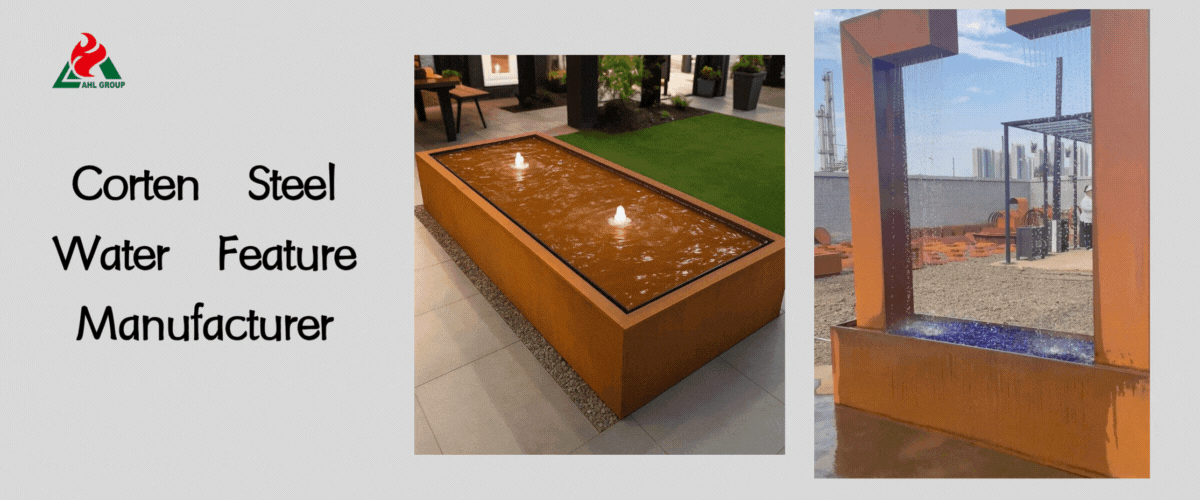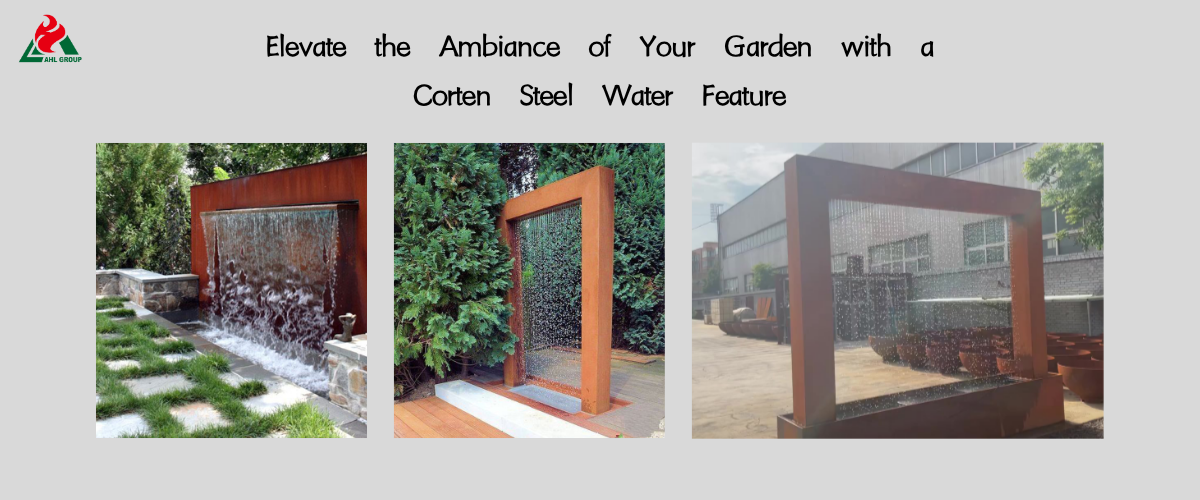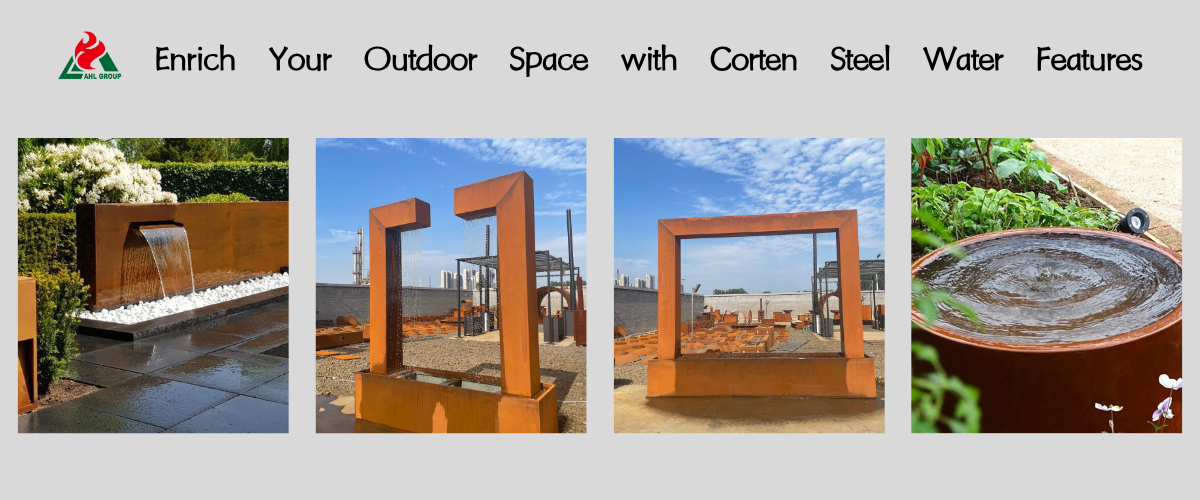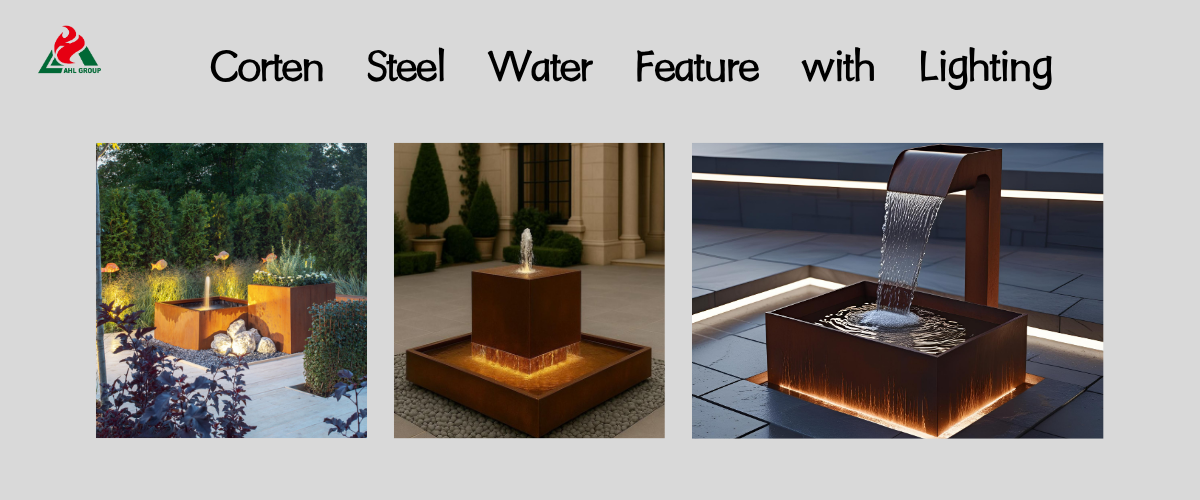Corten steel water features are not merely garden ornaments, but permanent architectural elements that anchor landscape design. Corten steel waterfalls, fountains, and cascading pools are renowned for their modern aesthetic appeal and decades-long durability. However, achieving a successful, worry-free installation demands meticulous planning—especially considering the unique properties of weathering steel and the requirement for seamless integration with electrical and plumbing systems.
As a premium manufacturer of Corten steel water features, AHL Group has identified 8 critical factors that professionals and DIY enthusiasts alike must address. Resolving these issues in advance ensures not only a stunning appearance for your Corten steel water feature garden but also guarantees trouble-free operation for years to come.

As a premium manufacturer of Corten steel water features, AHL Group has identified 8 critical factors that professionals and DIY enthusiasts alike must address. Resolving these issues in advance ensures not only a stunning appearance for your Corten steel water feature garden but also guarantees trouble-free operation for years to come.

Introduction to Corten Steel Water Feature Design
Before commencing construction, it is crucial to thoroughly understand material properties and project scale. Meticulous planning minimizes long-term maintenance issues and enhances return on investment.
The Allure of Weathering Steel in Water Features
The artistic appeal of weathering steel lies in its ability to develop a deep, rustic patina that creates striking contrasts with water and vibrant greenery. This stable protective layer effectively shields the underlying steel, making it a naturally durable material for outdoor environments. When incorporated into water features, weathering steel evolves into a dynamic visual focal point.
Why Thorough Planning is Key to Success
Unlike installing static garden ornaments, water feature projects involve electrical systems, plumbing, and specific leveling requirements. Inadequate planning can lead to leaks, excessive rust staining of patios, pump failures, and winter maintenance challenges. Successful installation hinges entirely on meticulous technical planning beforehand.

Key Consideration 1: Location and Layout
The microenvironment surrounding a Corten water feature significantly impacts its performance, maintenance requirements, and visual appeal.
Sunlight, Wind, and Tree Distance
• Sunlight: Full or partial sun is ideal. Sunlight helps Corten steel dry quickly after rain, promoting the formation of a stable rust layer. Excessive shade delays the drying process.
• Trees: Avoid placing the feature directly beneath deciduous trees. Fallen debris will continuously clog pump filters, and decaying material in the water will lower pH levels, acidifying the water and potentially corroding the steel over time.
Visual Integration and Landscape Design
Water features should serve as focal points within the space. Consider key viewing areas such as patios, living room windows, or decks. For example, with AHL water features, ensure the drop height and sound level align with the space—avoid excessive noise in small gardens and overly quiet settings in large ones.
Key Consideration 2: Water Supply and Power
Functional water features depend on a reliable and safe power supply and convenient water replenishment.
Ground Fault Circuit Interrupter (GFCI) Outlets and Water Source Configuration
All outdoor electrical components (including water pumps) must be connected to GFCI-protected outlets for safety. Plan cable routing using concealed burial or hidden installations. Additionally, easily accessible garden hoses or automatic refill lines simplify water level maintenance and effectively prevent pump overheating and burnout.
Low-Voltage Wiring and Cable Management Planning
Most weathering steel water features utilize 12V low-voltage pumps and corresponding lighting. While safer and easier to install than 120V systems, proper wiring management remains essential. Use waterproof connectors and ensure all cables are neatly contained—typically housed within the water feature's base or routed through dedicated conduits—to maintain visual appeal.
Key Consideration 3: Base Preparation and Leveling
For any water feature—especially heavy Corten steel pools—a solid foundation is essential to ensure longevity and functionality.
Creating a Stable, Level Base
Corten steel is inherently heavy, and its weight increases significantly when filled with water. The foundation must be solid and compacted to prevent settlement, which could cause the installation to tilt, leading to uneven water flow and potential leaks. A compacted sand layer, fine gravel layer, or poured concrete base is recommended as the subgrade.
Drainage and Stabilization Functions of the Gravel Layer
Placing the feature on a layer of dark, coarse gravel serves multiple purposes:
• Leveling: Allows for easy fine adjustments by shifting the gravel
• Drainage: Facilitates rapid water runoff around the steel base, crucial for developing the proper rust patina
• Runoff Management: During the initial weathering phase, the gravel layer acts as an absorbent layer, effectively controlling visible rust runoff from the weathering steel and protecting underlying patios or concrete surfaces.
Key Consideration 4: Waterproofing and Pump Selection
The heart of any water feature lies in its pump, whose performance hinges on internal seals and fluid dynamics design.
Ensuring Watertight Seals
Most AHL Group Corten steel water fountains utilize welding techniques, inherently providing waterproof properties. However, for multi-component systems or installations with internal piping connections, ensure all joints are securely fastened and apply high-quality UV-resistant silicone sealant at potential leakage points. Conduct a 24-hour water-filled test before final installation.
Selecting Appropriate Pump Size and Flow Rate
Pump specifications must match the installation's required head height and flow rate.
• Head Height: The maximum vertical distance the water flow must overcome.
• Flow Rate (Gallons per Hour): The volume of water required to achieve the desired effect (e.g., the difference between a gentle water curtain and a rushing waterfall). An undersized pump will result in weak water flow, diminishing both visual and auditory impact. Refer to manufacturer specifications and select recommended pump models suitable for Corten metal water features.

Key Consideration 5: Managing Weathering Steel Rust Layer
The initial weathering phase is critical for the material's long-term protection and aesthetic appeal.
Understanding and Controlling Rust Loss
Rust loss occurring during the first 6 to 18 months is normal, resulting from the washing away of excess iron oxide during the stabilization of the rust layer. Such loss may stain lighter surfaces. As noted in Consideration 3, the optimal control measure is to place components on dark gravel, wooden platforms, or dedicated weathering steel loss platforms.
Accelerating Rust Layer Formation for a Mature Appearance
To rapidly achieve a deep orange mature rust layer, a simple spraying regimen (water containing a small amount of salt or vinegar solution) can be applied during the initial weeks. Ensure components are completely dry after each application.
Key Consideration 6: Piping and Tubing Systems
Internal construction must possess durability comparable to the weathering steel itself.
Select Durable, Kink-Resistant Tubing
Choose heavy-duty black vinyl or polyethylene tubing with UV resistance. It must offer sufficient flexibility for routing while maintaining adequate rigidity to prevent kinking under pressure or heavy loads. Pipe distortion significantly reduces pump efficiency and flow rate.
Create a Concealed, Efficient Water System
Ensure all piping is securely connected to the pump and outlet using stainless steel hose clamps. All piping should be concealed within landscape structures or buried in the pool base to maintain a clean, professional appearance. Minimize bends when planning water routes to reduce friction resistance and maximize flow velocity.
Key Consideration 7: Frost Protection and Seasonal Maintenance
Neglecting frost protection is the quickest way to damage pumps and weathering steel landscape installations.
Protecting Installations from Freezing Temperatures
The primary threat stems not from the steel itself, but from water trapped in pumps, pipes, and reservoirs. Frozen water expands, causing pump housings and pipes to crack.
Winter Shutdown Step-by-Step Procedure
Before the First Frost:
• Drainage: Shut off pumps, disconnect all connections, and drain all water from landscape water features, pipes, and reservoirs.
• Pump Removal: Move pumps indoors, submerge them in a water-filled container (keeping seals moist), and store them in a temperature-controlled environment.
• Covering: Cover empty Corten steel landscape features with breathable, waterproof covers to prevent snow accumulation and debris from entering the basin.
Key Consideration 8: Long-Term Maintenance
Daily upkeep, though simple, is crucial for ensuring consistent equipment performance.
Regular Cleaning Schedule for Pumps and Filters
The pump is the most vulnerable component of the entire system. Clean the pump filter and impeller every 1-3 months during operation. Promptly removing accumulated debris extends pump lifespan while maintaining optimal flow rates.
Algae Control and Water Quality Management
Use algae control products explicitly labeled for metal water features. Avoid strong chlorine or acidic cleaners, as these erode the weathering steel's protective rust layer. Maintain a neutral pH (6.5 to 7.5) to balance the water and prevent internal steel corrosion.

Professional Installation Guide: Achieving Perfect Results
Corten steel water features are increasingly popular in modern landscape design for their unique charm and durability. Not only does this material offer a beautiful rust-resistant appearance, but it also blends seamlessly with the natural environment, creating a striking visual effect. However, successfully installing a Corten metal water feature requires careful planning and expertise.
Common Mistakes to Avoid
• Neglecting Drainage Systems: Ensure the lowest point of the landscape (water feature) has a clear drain outlet or access port for routine cleaning and winter drainage.
• Improper Leveling: Use a professional level when installing large water features; even slight tilts can ruin waterfall effects.
• Retained Wet Ash: For Corten steel fire pits with water features, never allow wet ash to remain in the basin, as the resulting alkaline solution is highly corrosive.
Maximizing Visual and Auditory Appeal
Strategically place LED accent lights within the water feature (immersed or directed toward the flow) to highlight rich rust textures at night. The sound of flowing water adds dynamic elements; ensure the pump power is sufficient to create the desired sound effect while avoiding excessive noise.
Conclusion: Ensuring Long-Lasting Investment Value
The successful installation of Corten steel water features hinges on meticulous planning for electrical systems, piping, and placement. By adhering to these eight critical considerations—from reinforcing the base with gravel to carefully managing pumps and rust layers—your investment in AHL Group's premium water fountains will deliver decades of enjoyment with minimal long-term maintenance costs.


